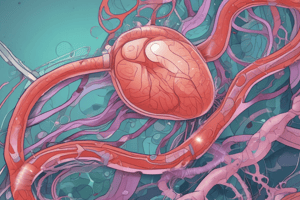Podcast
Questions and Answers
A nurse instructing teenage boys on the female anatomy should state that fertilization starts expected:
A nurse instructing teenage boys on the female anatomy should state that fertilization starts expected:
- Cervix
- Fallopian tube (correct)
- Ovary
- Uterus
The nurse determines that the client understands the function of the placenta if the following statement is made:
The nurse determines that the client understands the function of the placenta if the following statement is made:
- It gives the baby food and oxygen (correct)
- It warms the baby
- It cushions and protects the baby
- It passes antibodies to the fetus
Which chemical hormone keeps the corpus luteum alive until the placenta is formed?
Which chemical hormone keeps the corpus luteum alive until the placenta is formed?
- Human placental lactogen
- Testosterone
- Estrogen
- Progesterone
- Human chorionic gonadotropin hormone (correct)
During pregnancy it is expected that the fetus shares a blood supply with the mother.
During pregnancy it is expected that the fetus shares a blood supply with the mother.
The last menstrual period was December 06, 2022. Using Naegele's Rule, estimate the date of delivery?
The last menstrual period was December 06, 2022. Using Naegele's Rule, estimate the date of delivery?
A pregnancy could be completed to term even if the placenta is damaged or removed.
A pregnancy could be completed to term even if the placenta is damaged or removed.
The nurse caring for an Rh- client understands that she will first receive Rho(D) immune globulin:
The nurse caring for an Rh- client understands that she will first receive Rho(D) immune globulin:
If an infant is born with an abnormal color, which of the following is MOST likely to be examined?
If an infant is born with an abnormal color, which of the following is MOST likely to be examined?
Which of the following is most important to protect a fetus?
Which of the following is most important to protect a fetus?
At 34 weeks pregnant, which of the following statements would make a nurse suspect preeclampsia?
At 34 weeks pregnant, which of the following statements would make a nurse suspect preeclampsia?
The anticoagulant medication that can safely be administered during pregnancy is:
The anticoagulant medication that can safely be administered during pregnancy is:
The most common cyanotic congenital heart disease is:
The most common cyanotic congenital heart disease is:
Flashcards are hidden until you start studying
Study Notes
Fertilization and Anatomy
- Fertilization occurs in the fallopian tube before the egg moves to the uterus for development.
- Understanding of female anatomy is crucial for educating teenagers.
Function of the Placenta
- The placenta provides nutrients, oxygen, and waste exchange between mother and fetus.
- It acts as an endocrine organ, producing hormones to regulate maternal and fetal physiology during pregnancy.
Hormones in Pregnancy
- Human chorionic gonadotropin hormone (hCG) is essential for maintaining the corpus luteum, which supports early pregnancy until the placenta develops.
Blood Supply During Pregnancy
- The blood supplies of the mother and fetus are separate, preventing direct mixing of maternal and fetal blood.
Naegele's Rule for Due Date Calculation
- Due date can be estimated using Naegele's Rule:
- Last menstrual period: December 06, 2022
- Expected due date: September 13, 2023 (subtract 3 months, add 7 days, adjust year).
Placenta Status in Pregnancy
- If the placenta is damaged or removed, pregnancy cannot be carried to term.
Rho(D) Immune Globulin Administration
- Rh-negative pregnant clients typically receive their first dose of Rho(D) immune globulin at 28 weeks of gestation.
Infant Color Abnormalities
- An abnormal color in infants, such as jaundice, necessitates checking the bilirubin level.
Fetal Protection
- Amniotic fluid acts as a protective cushion for the fetus, safeguarding it during development.
Signs of Preeclampsia
- Symptoms like hand or facial swelling may indicate preeclampsia; clients may notice changes in ring fit due to edema.
Safe Anticoagulant in Pregnancy
- Heparin sodium is the preferred anticoagulant during pregnancy, as it does not cross the placental barrier.
Common Congenital Heart Disease
- Tetralogy of Fallot is the most common cyanotic congenital heart defect, while transposition of the great arteries is a leading cause of neonatal cyanosis.
Gonadotropin-Releasing Hormone (GnRH)
- Understanding the primary purpose of GnRH and its role in the reproductive system is essential for nurses in maternal and child health.
Studying That Suits You
Use AI to generate personalized quizzes and flashcards to suit your learning preferences.



